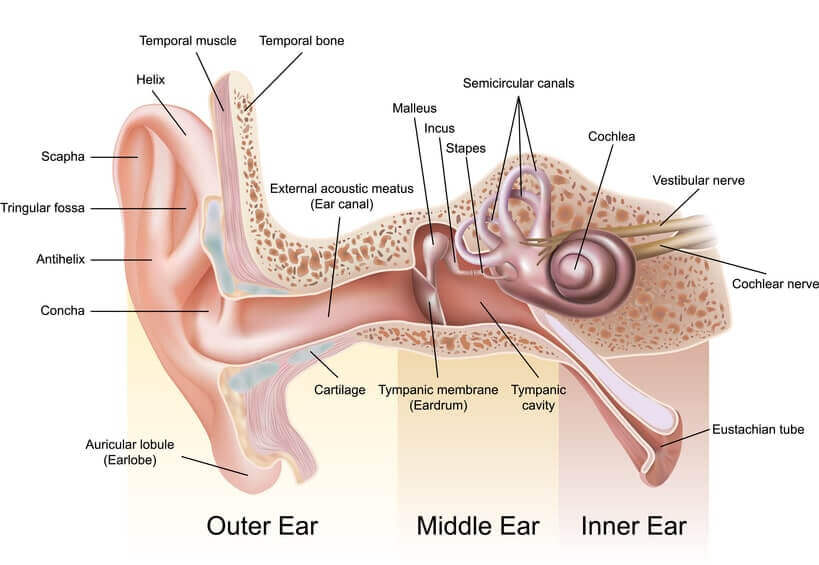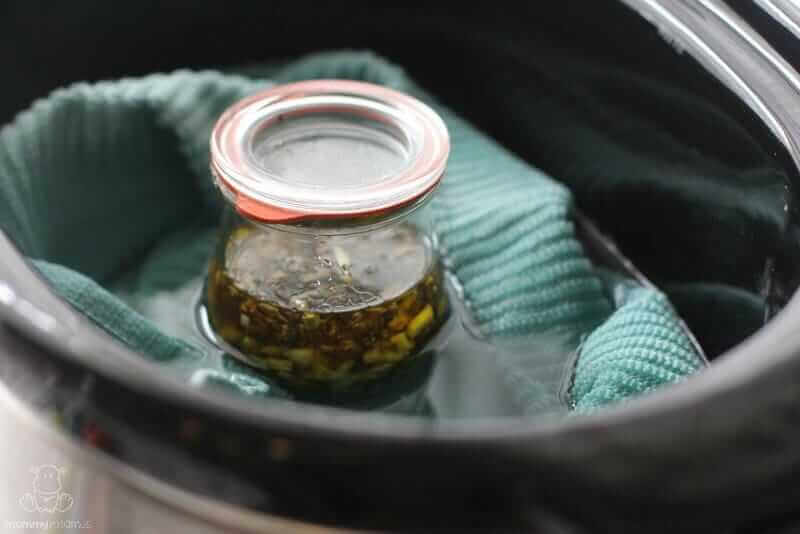
This may be an odd way to start a post on home remedies for earaches, but before we get into the nitty gritty of easy homemade ear drops, warm salt socks and other comfort measures, I want to take a moment to discuss one of the most common misconceptions about ear infections.
And that would be . . . the infection part. According to Dr. Allan Lieberthal, pediatrician and lead author of the American Academy of Pediatrics new guidelines for diagnosing ear infections, the medical community has contributed to the “over-diagnosis of [ear] infection.” (1)
How does this happen? Dr. Haggerton, a pediatric and family chiropractor, explains:
Many of us have gone through this in the past: We’ve taken our child to the pediatrician because they are obviously in pain, acting funny, or pulling at their ears, and the doc looked in their ears with the otoscope and said, “Yep, it’s red. Little Johnny’s got an ear infection. I’ll write you a script for an antibiotic.
Think about that for a minute. How did the doctor know, just from the color of the tympanic membrane (eardrum), that your child had an infection? He didn’t. The only way to truly diagnose an infection in the ear is by doing a swab of the ear and culturing the area. Then they can see for sure whether or not your child actually has an infection. If they don’t do that, the problem more than likely is fluid buildup behind the eardrum.” (2)

So what causes ear pain?
A red and slightly bulging tympanic membrane can be a sign that fluid is not draining well, but it’s not necessarily a sign of ear infection.
Children’s eustachian tubes (ear canals) are not slanted down like those of adults. Their canals are straight across or horizontal, making it hard for your baby to get much help from gravity to move the fluid from the lymph nodes and the ears into the throat and out of their body. The problem comes when fluid and congestion build up in the lymph nodes in the sides of the neck and throat and cannot be moved or flushed out of the child’s body.
That fluid has to go somewhere, so if the fluid can’t go back down, then it will frequently back up into the child’s Eustachian tube, causing fluid pressure on the back of the ear drum. This pressure will cause swelling and irritation—pain—just like an infection, and if left unaddressed long enough can progress into an infection.” (2)
Other than the natural shape of a child’s eustachian tube, misalignments in the head/neck area, teething and/or undiagnosed food sensitivities can cause swelling that prevents drainage. (3) In these cases, the irritation will often have the same symptoms as an infection.
Why The American Academy of Pediatrics Now Recommends The “Wait & See” Approach
Even if an infection is present, according to CBS News Medical Correspondent Dr. Jennifer Ashton most ear infections are viral in nature and won’t respond to antibiotics anyway. (4)
So what will that course of antibiotics really do to help? If the earache has been misdiagnosed – absolutely nothing. Or worse, according to Consumer Reports it may actually cause future ear infections! (5)
The AAP Guidelines now state that antibiotics should not be prescribed unless there is an obvious ear infection – a very bulging tympanic membrane. If fluid is present some parents might insist on a swab culture to confirm it is bacterial rather than viral before considering antibiotics. If they do, chances are the earache will resolve on it’s own before the results come back. According to the American Academy of Pediatrics, that may be for the best anyway. Most ear infections – whether truly an infection or not – clear up without any treatment.
According to a Cochrane Review which reviewed earache treatments for several thousand children, researchers found that antibiotics did not decrease pain within the first 24 hours. About 60% of children recovered on their own by this point.
Children who received antibiotics did report a slight improvement in pain on days two and three, but the researchers pointed out that children treated with antibiotics had a higher rate of adverse events such as vomiting, diarrhea and rash. They concluded that the “benefits of antibiotics must be weighed against the possible harms.”
There was no difference in pain between treated and untreated children “three to seven days and 11 to 14 days after assessment,” and researchers found that there was also no difference in the long-term outcomes they examined.
Wait-And-See Guidelines (Plus When To See A Doctor)
According to Lieberthal, the “Basic rule of thumb for parents is: Don’t call the doctor for an antibiotic unless the child has a fever over 102 degrees or severe symptoms of cough, runny nose and ear pain.”
Instead, he writes, “a parent can safely wait 48 to 72 hours, giving pain medicine as needed, and watching to see if those symptoms simply go away. If the fever rises or the cough and runny nose last for several days, that’s when the child needs to visit the doctor for a full evaluation.” (1)
The AAP recommends the wait-and-see approach for:
- Children 6 to 23 months with mild inner ear pain in one ear for less than 48 hours and a temperature less than 102.2 F (39 C)
- Children 24 months and older with mild inner ear pain in one or both ears for less than 48 hours and a temperature less than102.2 F (39 C) (6)
This approach has worked very well for my family, but I want to emphasize that these are guidelines, not rules. If your gut tells you to take your child in, by all means take them in and use the information your doctor shares with you to make an informed decision.
Recently one of my kids got hurt playing outside, and my gut told me that this time was different than other occasions. Turns out it was a mild collarbone break, and I’m so glad we went in. Even if it hadn’t been broken there are times when an outside opinion is helpful for putting the mind at ease, and I’m totally in favor of getting an opinion if it can help guide decision making.
Also, sometimes it can take a couple of days to get an appointment, so it may make sense to schedule just in case a couple of days go by and things don’t seem to be improving.
9 Home Remedies For Earaches
In the meantime, those (including myself) who choose the wait-and-see approach recommended by the AAP opt to support the immune system naturally while focusing on comfort measures.
For individuals that prefer to avoid Tylenol and other over-the-counter pain medications that may delay the healing process, below are nine ideas.
But first, a quick safety note: If the eardrum is perforated, nothing should be put in the ears. This Dr. Mom pocket otoscope was designed by an ER physician to help moms see what is going on when their little ones have an earache. It comes with a link to high resolution photos of normal and abnormal eardrums. The ER doctor also includes instructions on how to properly use the otoscope.
Okay, on to the remedies:

1. Olive Oil Infused With Garlic and/or Mullein (Herbal Ear Drops)
Warm olive oil, often infused with herbs such as garlic or mullien, has a long history of use as a folk remedy for earaches, and current research seems to support this approach.
In one study, researchers compared two treatment approaches for children with ear pain and clinical findings associated with middle ear infections (acute otitis media):
- Antibiotics + Ear Drops – This method included treatment with amoxicillin plus ear drops that were infused with garlic (allium sativum), mullein (verbascum thapsus), calendula (calendula flores), Saint John’s wort (hypericum perforatum), lavender, and vitamin E in olive oil.
- Ear Drops Alone – This approach included the herbal ear drops described above without the antibiotic.
What they found is that “Patients who were given ear drops alone had a better response than patients who were given ear drops together with amoxicillin.” (7)
The American Academy of Pediatrics, while noting that not enough research has been done to make definitive recommendations, also “says it could be moderately effective on ear pain.” (8)
Bonus fact: Garlic contains alliin and allinase. When a whole clove is chopped or crushed these compounds combine to form allicin, a compound with soothing properties that may provide a measure of comfort while garlic does it’s other magic. Garlic also has been shown to inhibit some viruses, which some people feel is helpful given that most earaches are viral in nature. (9)
You can find garlic and mullein oil here or possibly at your local health food store. I also have a garlic and mullien oil recipe that includes instructions for use if you’d rather make it.

2. Salt Sock or Warm Compress
Warmth does wonders for getting the lymphatic fluid moving and easing the discomfort of earaches. I tried the salt sock remedy recommended by Lillian Beard, M.D. with one of my littles last year and it was very helpful. Although salt is my preference because it has antimicrobial properties, rice works well, too.
Another option is a warm water bottle held over the aching ear or an onion poultice. (More on how to make an onion poultice below.)
3. Massage With or Without Essential Oils
Massaging the outside of the ear and face/jaw/neck area with a carrier oil and – if you have them on hand – a few drops of essential oil is thought to encourage good circulation and facilitate normal drainage. Here’s a video that shows how to use this method.
Oils often recommended for this purpose are tea tree, eucalyptus, rosemary, lavender, oregano, chamomile, peppermint and thyme. Please keep in mind that some oils should not be introduced until child reaches a certain age. I’ve created a guide to diluting essential oils and a list of child-friendly essential oils, but for this specific purpose here are some recommendations based on the oils mentioned above:
Oils considered safe for children ages 3 months – 6 years:
- Chamomile/German (Matricaria chamomilla L)
- Chamomile/Roman (Chamaemelum nobile)
- Lavender (Lavandula augustifolia)
- Tea tree (Melaleuca alternifolia)
Dilution recommendations:
For children ages 3 months – 2 years, the recommended dilution ratio is .25% (1 drop per 4 teaspoons carrier oil)
For children ages 2 years – 6 years, the recommended dilution ratio is 1% (1 drop per teaspoon of carrier oil)
Essential oils that are considered safe for children 6-10:
- Peppermint (Mentha x piperita)
- Eucalyptus (Eucalyptus radiata)
- Eucalyptus (Eucalyptus globulus)
- Rosemary (Rosemarinus officinalis)
Dilution recommendations: For children ages 6-15, the recommended dilution ratio is 1.5% (9 drops in 2 tablespoons of carrier oil)
Special cases: Eucalyptus & Peppermint
Both of these oils are generally not recommended for use with young children due to their high concentration of 1.8 cineole, which can sometimes acts negatively on the temperature receptors of children’s lungs and cause slowed breathing. However, there are exceptions to this guideline, which you can read about here.
4. Cod Liver Oil
According to Dr. Michael Gerber, “Vitamin A deficiency disrupts the clearing mechanism of the ear.” (10) He makes a distinction between betacarotene and true Vitamin A, which is only found in animal products such as cod liver oil. (Read more about cod liver oil here.)
5. Chiropractic Care
According to researchers who examined the role of chiropractic in treating and preventing earaches, “results indicate that there is a strong correlation between the chiropractic adjustment and the resolution of otitis media for the children in this study.” (11)
That’s likely because, as mentioned above, the lymph system needs to work well in order to prevent the buildup of fluid in the ear. When misalignment occurs it can restrict flow, however they can be restored to optimal function with appropriate chiropractic care.

6. Elderberry Syrup & Tea
According to Penn State Medical Center, elderberry may have anti-inflammatory and antiviral properties. Among the various natural remedies for ear infections, it is a favorite with those who want to support the immune system naturally.
Click here for my elderberry syrup recipe and video tutorial, or buy it here. Another way to use this revered herb is to make elderberry tea.
7. Colloidal Silver
Recommendations seem to hover around one to three drops – warmed before use – inserted twice a day. Emily Bartlett, LAc has a great article on why it is safe but should be used sparingly.
8. Onion Poultice
The warmth of a fresh onion poultice is said to provide comfort and assist with circulation. Onion is also believed to have antibacterial and antiviral properties, which may be helpful depending on the reason for the discomfort.
To make an onion poultice:
- Chop an onion (any color) in half
- Place it face down in a pan along with a tablespoon of water
- Cook on medium heat until the water has evaporated
- Wrap the onion half in a cotton towel and wait until it has cooled enough to be placed comfortably against the ear
- Place the towel-wrapped onion against the ear and let it sit for 10 minutes or so, or until it cools. Repeat the process with the same onion 1-2 more times if desired.
Another option is to squeeze out some of the onion juice after you remove it from the stovetop and after it has cooled – put a few drops into the ear.
9. Hydrogen Peroxide
Many moms swear by this method, which is helpful for both removing earwax buildup and creating an inhospitable environment for unwanted microbes. Here’s what to do:
- Mix up a 1:1 solution of purified water and hydrogen peroxide (that’s equal parts of each)
- Lie down on one side with the achy ear facing up. If you’re administering drops to a child, have them lay on one side either on your lap or against a pillow.
- Use a dropper to place a few drops of the solution in the ear canal. It may bubble up and tickle a bit – that’s okay.
- Stay still for five minutes or so. If needed, distract a child with a movie or reading a book.
- After the five minutes is up, roll over (or allow the child to roll over) and let the peroxide solution pour into a towel.
Other Common Causes of Ear Pain
Ear pain can also be caused by:
- Injury
- Fluid trapped in the ear, which is sometimes called swimmers ear
This post is focused on earaches that are due to congestion/inflammation, but you can find natural remedies for swimmers ear here.
Prevention Strategies
The majority of our immune system is found in the digestive tract, so supporting it with beneficial bacteria is recommended by many practitioners. If ear inflammation is due to food sensitivities, it may also be beneficial in helping to moderate and even reverse those sensitivities over time using protocols such as the GAPS Diet.
In this study, researchers found that giving children a probiotic with a strain called Streptococcus salivarius K12 was associated with fewer and less severe ear infections. This is the same strain used in the probiotic I give my kids for oral health.
Regular chiropractic care may also be helpful for improving drainage in the ear canal.
Products mentioned in this post:
- Garlic & Mullein Oil
- Cod Liver Oil
- Elderberry Syrup
- German Chamomile Essential Oil (Matricaria chamomilla L)
- Roman Chamomile Essential Oil (Chamaemelum nobile)
- Lavender Essential Oil (Lavandula augustifolia)
- Tea Tree Essential Oil (Melaleuca alternifolia)
- Peppermint Essential Oil (Mentha x piperita)
- Eucalyptus Essential Oil (Eucalyptus radiata)
- Eucalyptus Essential Oil (Eucalyptus globulus)
- Rosemary Essential Oil (Rosemarinus officinalis)
Other popular remedies for kids:
- One study suggests that the main ingredient in this homemade cough syrup is more effective than dextromethorphan, which is the active ingredient in OTC cough syrup.
- Growing up shouldn’t be a pain, but sometimes it is! Here are some natural remedies that studies suggest may help with growing pains.
- Pin these natural remedies for lice, then you hope you never need them!
- New research suggests that fevers are beneficial. Here’s what two distinguished pediatricians have to say on the subject, plus five natural ways to soothe a feverish child.
- Check out this homemade burn salve for minor uh-ohs.
Have you tried any natural remedies for ear infections? How did they work for you?
Article sources:
1. Tribble, Sarah Jane (2013) Ear infection? New guidelines say don’t rush to the doctor. Retrieved from https://ift.tt/2TINoRY
2. Haggerton, JB (2015) Pathways To Family Wellness Magazine. Issue #45
3. Net Wellness Non-Profit Healthcare. Serious Otitis Media. Retrieved from https://ift.tt/2J9XNBP
4. CBS News (2010) Study: Leave Ear Infections Alone. Retrieved from https://ift.tt/2TLNcBi
5. Consumer Reports (2009) Antibiotics For An Ear Infection Lead To . . . More Ear Infections. Retrieved from https://ift.tt/2JelAke
6. Mayo Clinic. Ear Infection (Middle Ear). Retrieved from https://ift.tt/2g7OKQH
7. Sarrell, EM et. al. (2003) Naturopathic Treatment For Ear Pain In Children. Retrieved from https://ift.tt/2J7qwY2
8. WebMD. How Can You Use Olive Oil For An Ear Infection? Retrieved from https://ift.tt/2TPo4JO
9. Ankri, S and Mirelman, D. (1999) Antimicrobial Properties of Allicin From Garlic. Retrieved from https://ift.tt/1QA9EE2
10. Gerber Medical Clinic (2011) The Power of Vitamin A. Retrieved from https://ift.tt/2TKwbr1
11. Journal of Clinical Chiropractic Pediatrics. The Role of the Chiropractic Adjustment in the Care and Treatment of 332 Children with Otitis Media. Retrieved from https://ift.tt/2JpdntN
Continue reading Earache: 9 Effective Home Remedies...
from Mommypotamus https://ift.tt/2TMFOFM
 Reviewed by Unbelievable Tamil Facts
on
March 13, 2019
Rating:
Reviewed by Unbelievable Tamil Facts
on
March 13, 2019
Rating:



No comments: